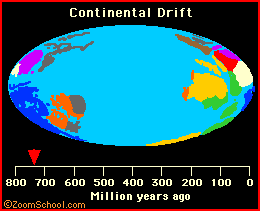
 |
Volcano Info |
Volcano Dictionary |
Volcano Activities and Printouts |
|
| Types of Volcanoes | The Ring of Fire | ||
| A | B | C | D | E | F | G | H | I | J | K | L | M | N | O | P | Q | R | S | T | U | V | W | X | Y | Z |
caldera A caldera is a large depression formed from a collapsed volcano. Calderas are often circular or elliptical. Crater Lake (in Oregon, USA) is an example of a large caldera (it is 16 miles across). Caldera comes from the Spanish word for Cauldron. |
Cenozoic era The "Age of Mammals" (65 million years ago - today), saw the emergence of familiar life forms, humans, the modern look of the continents, and a cooling climate. The Cenozoic followed the Mesozoic Era. |
cinders Cinders are small fragments of lava that are about 1/2 inch (1 centimeter) across. |
conduit A volcanic conduit is a passage through which magma (molten rock) flows in a volcano. |
 continental drift Continental drift is the movement of the Earth's continents. The land masses are hunks of Earth's crust that float on the molten core. The ideas of continental drift and the existence of a supercontinent (Pangaea) were presented by Alfred Wegener in 1915. |
continental plates The crust of the Earth is broken into plates. The plates are enormous chunks of rock that float atop the soft mantle. The plates are moving at a speed that has been estimated at 1 to 10 cm per year. Continental plates are thicker, older, and less dense than oceanic plates. These plates are about 125 kilometers thick and are made of granite that is about 3 billion years old. |
continental shelf The continental shelf is the part of the ocean floor next to each of the continents. The sea floor slopes gradually from the continent to a depth of about 650 feet (200 m). Beyond the continental shelf the sea floor drops steeply. |
core The core is the innermost layer of the Earth. It consists of iron-nickel; it is under great pressure and is very hot. The inner core is solid ; the outer core is molten. |
Coriolis force The Coriolis force is the force that results from the rotation of the Earth around its axis; it makes storms rotate counterclockwise in the Northern and clockwise in the Southern Hemispheres. The French engineer/mathematician Gustave-Gaspard Coriolis discovered this force in 1835. This force has effects on water currents, but has no effect on the direction of water going down a drain. |
crater A crater is a circular depression in the ground. It has steep sides and contains a volcanic vent. |
|
Flowering plants appeared and dinosaurs were at their height during the Cretaceous period, 146-65 million years ago. There was a mass extinction (the K-T mass extinction) at the end of the Cretaceous, marking the end of the dinosaurs and many other species. Modern-day sharks existed during the Cretaceous period. |
crust The Earth's crust is its outermost, rocky layer. |
Volcano Info |
Volcano |
Volcano Activities and Printouts |
|
| Types of Volcanoes | The Ring of Fire | ||
| A | B | C | D | E | F | G | H | I | J | K | L | M | N | O | P | Q | R | S | T | U | V | W | X | Y | Z |
Enchanted Learning®
Over 35,000 Web Pages
Sample Pages for Prospective Subscribers, or click below
|
Overview of Site What's New Enchanted Learning Home Monthly Activity Calendar Books to Print Site Index K-3 Crafts K-3 Themes Little Explorers Picture dictionary PreK/K Activities Rebus Rhymes Stories Writing Cloze Activities Essay Topics Newspaper Writing Activities Parts of Speech Fiction The Test of Time
|
Biology Animal Printouts Biology Label Printouts Biomes Birds Butterflies Dinosaurs Food Chain Human Anatomy Mammals Plants Rainforests Sharks Whales Physical Sciences: K-12 Astronomy The Earth Geology Hurricanes Landforms Oceans Tsunami Volcano |
Languages Dutch French German Italian Japanese (Romaji) Portuguese Spanish Swedish Geography/History Explorers Flags Geography Inventors US History Other Topics Art and Artists Calendars College Finder Crafts Graphic Organizers Label Me! Printouts Math Music Word Wheels |
Click to read our Privacy Policy
| Search the Enchanted Learning website for: |